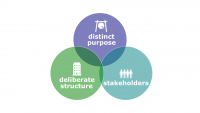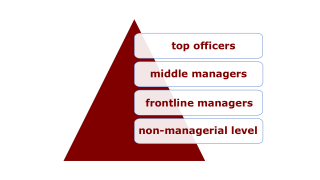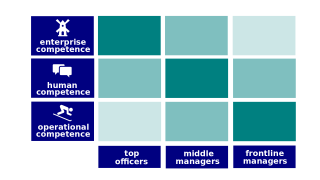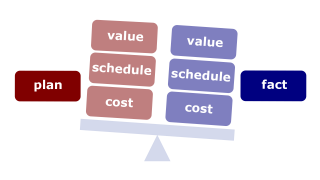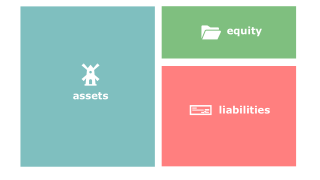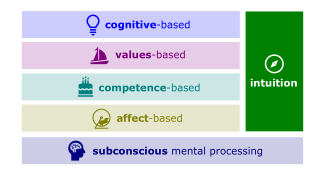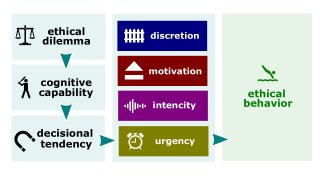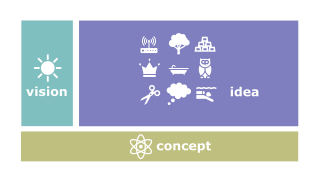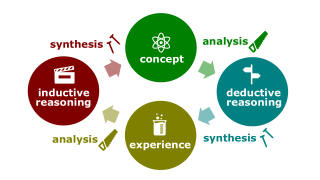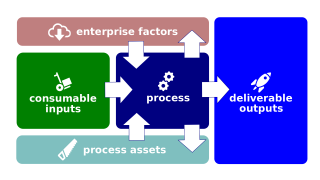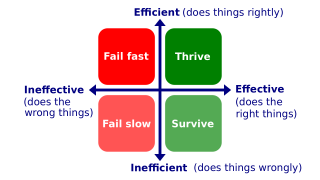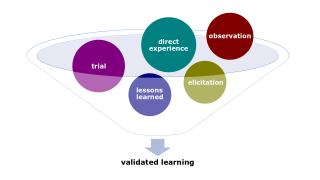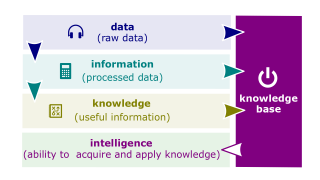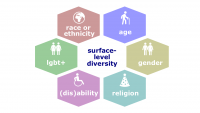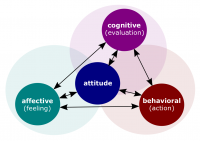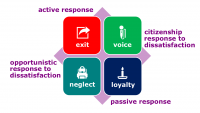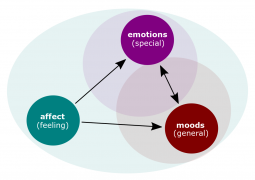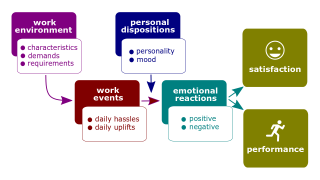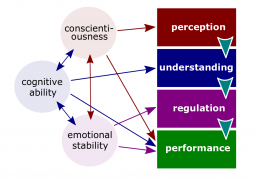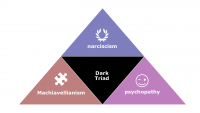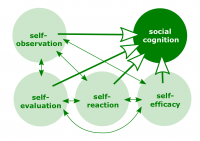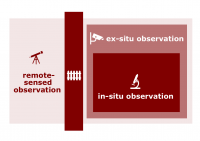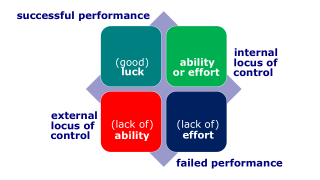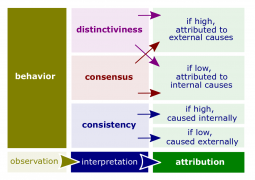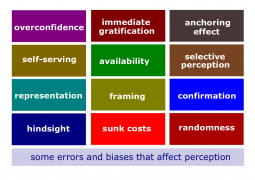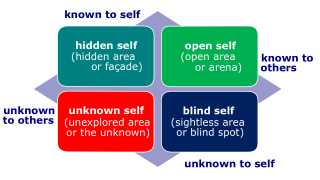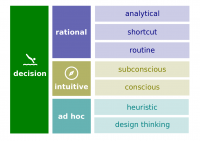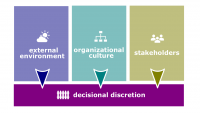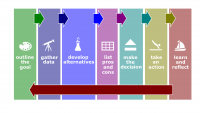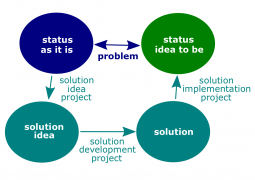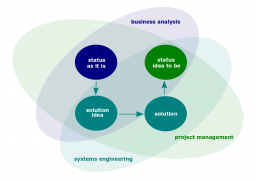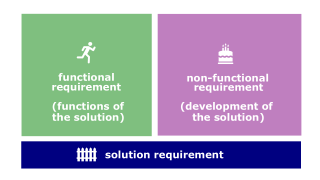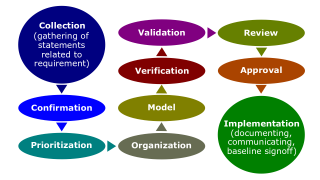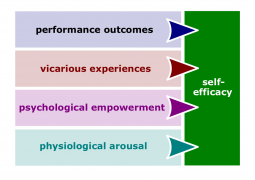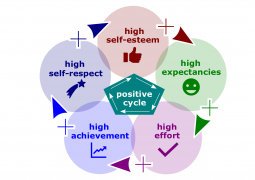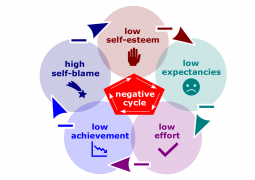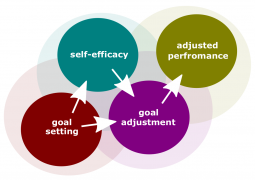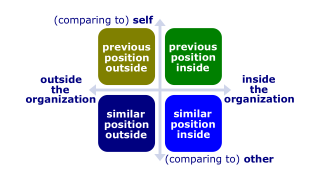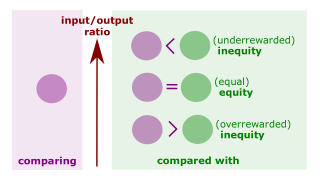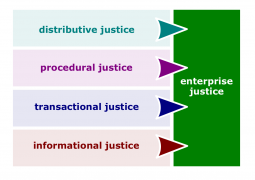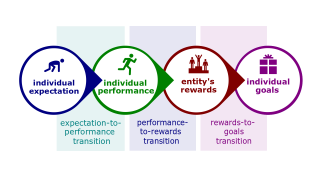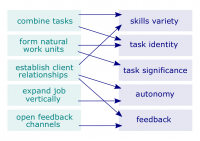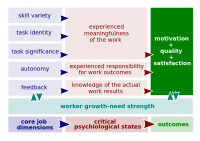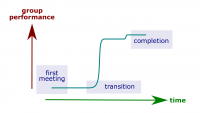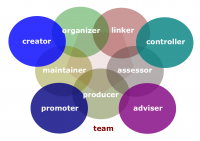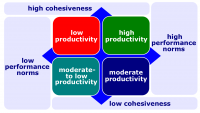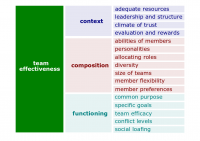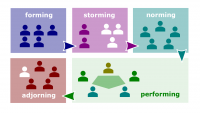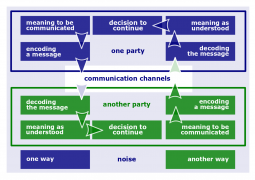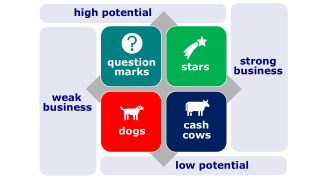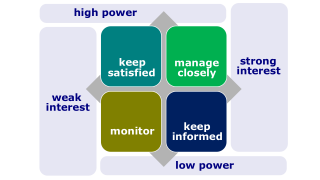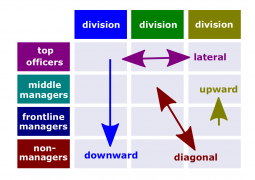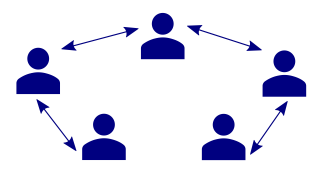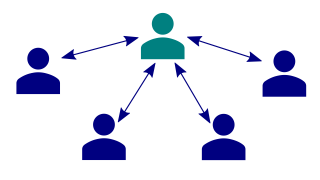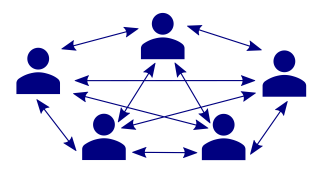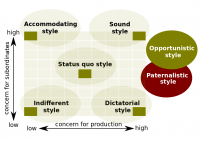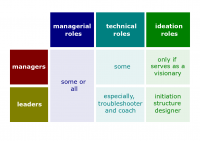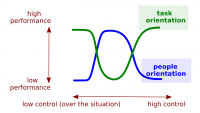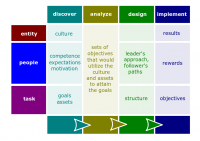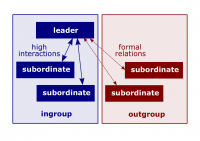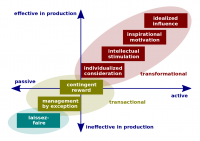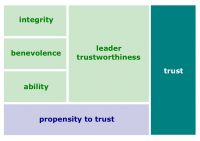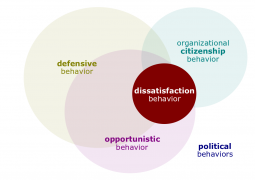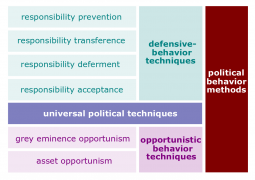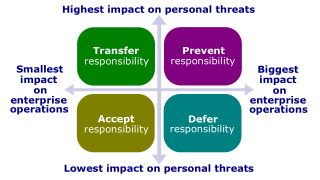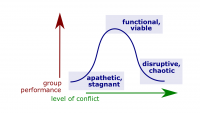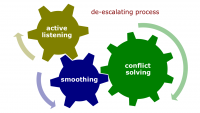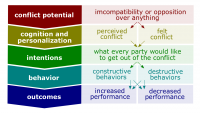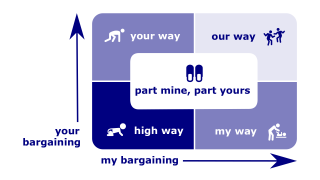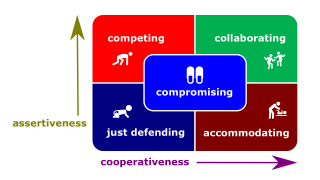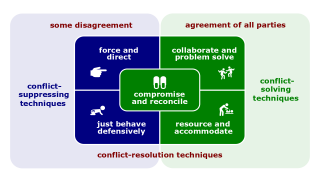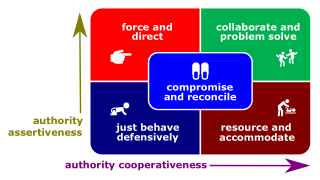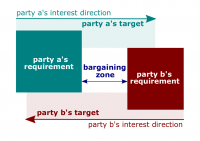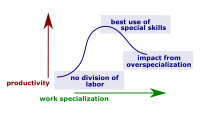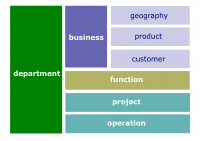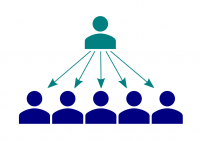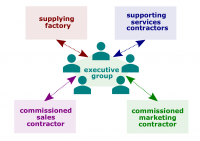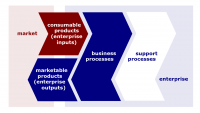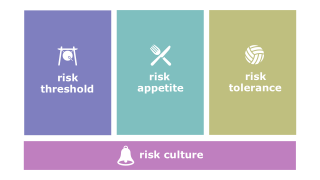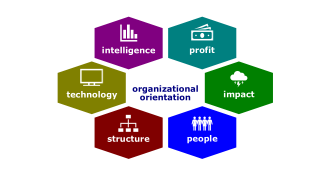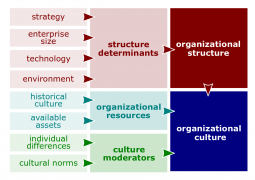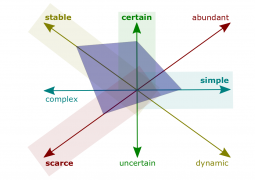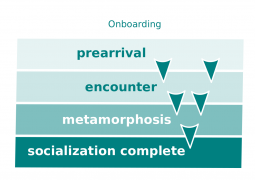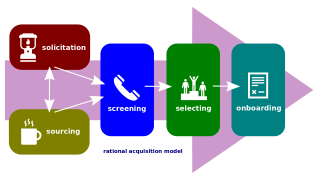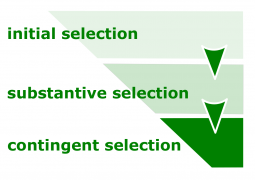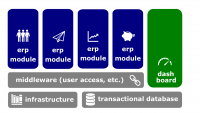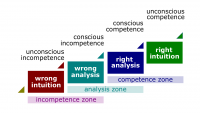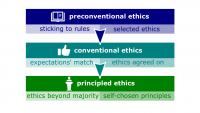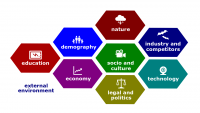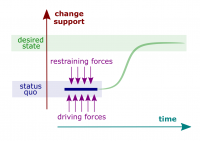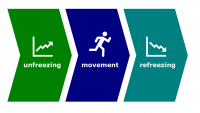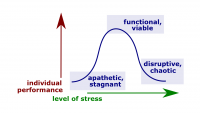Organizational Behavior by Robbins and Judge (17th edition)
Organizational Behavior by Robbins and Judge (17th edition) is the 17th edition of the college textbook that is titled Organizational Behavior, has been written by Stephen P. Robbins and Timothy A. Judge and published by Pearson Education, Inc. Vaughn College of Aeronautics and Technology utilizes this textbook for its Vaughn College MGT210 course.
Contents
- 1 Recitals
- 2 Diversity
- 3 Attitudes
- 4 Job satisfaction
- 5 Emotions and moods
- 6 Personality
- 7 Values
- 8 Perception
- 9 Decision making
- 10 Motivation
- 11 Motivation applications
- 12 Group behavior
- 13 Workteam
- 14 Communication
- 15 Leadership
- 16 Power
- 17 Politics
- 18 Conflict
- 19 Negotiation
- 20 Organizational structure
- 21 Organizational culture
- 22 HR
- 23 Organizational change
- 24 Stress management
Recitals
- Manager. An individual who achieves goals through other people.
- Organization. A consciously coordinated social unit, composed of two or more people, that functions on a relatively continuous basis to achieve a common goal or set of goals.
- Planning. A process that includes defining goals, establishing strategy, and developing plans to coordinate activities.
- Organizing. Determining what tasks are to be done, who is to do them, how the tasks are to be grouped, who reports to whom, and where decisions are to be made.
- Leading. A function that includes motivating employees, directing others, selecting the most effective communication channels, and resolving conflicts.
- Controlling. Monitoring activities to ensure they are being accomplished as planned and correcting any significant deviations.
- Organizational behavior. A field of study that investigates the impact individuals, groups, and structure have on behavior within organizations, for the purpose of applying such knowledge toward improving an organization's effectiveness.
- Systematic study. Looking at relationships, attempting to attribute causes and effects, and drawing conclusions based on scientific evidence.
- Evidence-based management. The basing of managerial decisions on the best available scientific evidence.
- Intuition. An instinctive feeling not necessarily supported by research.
- Psychology. The science that seeks to measure, explain, and sometimes change the behavior of humans and other animals.
- Social psychology. An area of psychology that blends concepts from psychology and sociology to focus on the influence of people on one other.
- Sociology. The study of people in relation to their social environment and culture.
- Anthropology. The study of societies to learn about human beings and their activities.
- Contingency variable. A situational factor that moderates the relationship between two or more variables.
- Positive organizational scholarship. An area of organizational behavior research that concerns how organizations develop human strengths, foster vitality and resilience, and unlock potential.
- Ethical dilemma. A situation in which individuals are required to define right and wrong conduct.
- Model. An abstraction of reality, a simplified representation of some real-world phenomenon.
- Input. A variable that leads to processes.
- Process. An action that individuals, groups, and organizations engage in as a result of inputs and that leads to certain outcomes.
- Outcome. A key factor that is affected by some other variables.
- Task performance. The combination of effectiveness and efficiency at doing core job tasks.
- Organizational citizenship behavior. Discretionary behavior that contributes to the psychological and social environment of the workplace.
- Withdrawal behavior. The set of actions employees take to separate themselves from the organization.
- Productivity. The combination of the effectiveness and efficiency of an organization.
- Effectiveness. The degree to which an organization meets the needs of its clientele or customers.
- Efficiency. The degree to which an organization can achieve its ends at a low cost.
- Organizational survival. The degree to which an organization is able to exist and grow over the long term.
Diversity
- Diversity. The extent to which members of a group are similar to, or different from, one another.
- Organizational demography. The degree to which members of a work unit share a common demographic attribute, such as age, sex, race, educational level, or length of service in an organization, and the impact of this attribute on turnover.
- Workforce diversity. The concept that organizations are becoming more heterogeneous in terms of gender, age, race, ethnicity, sexual orientation, and other characteristics.
- Surface-level diversity. Differences in easily perceived characteristics, such as gender, race, ethnicity, age, or disability, that do not necessarily reflect the ways people think or feel but may activate certain stereotypes.
- Deep-level diversity. Differences in values, personality, and work preferences that become more important for determining similarity as people get to know each other.
- Discrimination. Noting of a difference between things; often we refer to unfair discrimination, which means making judgments about individuals based on stereotypes regarding their demographic group.
- Biographical characteristic. A personal characteristic -- such as age, gender, race, and length of tenure -- that are objective and easily obtained from personnel records. These characteristics are representative of surface-level diversity.
- Positive diversity climate. In an organization, an environment of inclusiveness and an acceptance of diversity.
- Professional ability. An individual's capacity to perform the various tasks in a job.
- Intellectual ability. An individual's capacity to do mental activities -- thinking, reasoning, and problem solving.
- General mental ability. An overall factor of intelligence, as suggested by the positive correlations among specific intellectual ability dimensions.
- Physical ability. An individual's capacity to do tasks that demand stamina, dexterity, strength, and similar characteristics.
- Diversity management. The process and programs by which managers make everyone more aware of and sensitive to the needs and differences of others.
Attitudes
- Attitude. An evaluative statement or judgment concerning objects, people, or events.
- Cognitive component. The opinion or belief segment of an attitude.
- Affective component. The emotional or feeling segment of an attitude.
- Behavioral component. The behavioral segment of an attitude that constitutes an intention to behave in a certain way toward someone or something.
- Cognitive dissonance. Any incompatibility between two or more attitudes or between behavior and attitudes.
Job satisfaction
- Job satisfaction. A positive feeling about one's job resulting from an evaluation of its characteristics.
- Job involvement. The degree to which a person identifies with a job, actively participates in it, and considers performance important to self-worth.
- Psychological empowerment. Employee's belief in the degree to which they affect their work environment, their competence, the meaningfulness of their job, and their perceived autonomy in their work.
- Organizational commitment. The degree to which an employee identifies with a particular organization and its goals and wishes to maintain membership in the organization.
- Perceived organizational support. The degree to which employees believe an organization values their contribution and cares about their well-being.
- Employee engagement. An individual's involvement with, satisfaction with, and enthusiasm for the work he or she does.
- Corporate social responsibility. An organization's self-regulated actions to benefit society or the environment beyond what is required by law.
- Exit. Dissatisfaction expressed through behavior directed toward leaving the organization.
- Voice. Dissatisfaction expressed through active and constructive attempts to improve conditions.
- Loyalty. Dissatisfaction expressed by passively waiting for conditions to improve.
- Neglect. Dissatisfaction expressed through allowing conditions to worsen.
- Counterproductive work behavior. Actions that actively damage the organization, including stealing, behaving aggressively toward coworkers, or being late or absent.
Emotions and moods
- Affect. A broad range of feelings that people experience.
- Emotion. Intense feelings that are directed at someone or something.
- Mood. Feelings that tend to be less intense than emotions and that lack a contextual stimulus.
- Moral emotion. An emotion that have moral implications.
- Positive affect. A mood dimension that consists of specific positive emotions such as excitement, enthusiasm, and elation at the high end.
- Negative affect. A mood dimension that consists of specific negative emotions such as nervousness, stress, and anxiety at the high end.
- Positivity offset. The tendency of most individuals to experience a mildly positive mood at zero input (when nothing in particular is going on).
- Affect intensity. Individual differences in the strength with which individuals experience their emotions.
- Illusory correlation. The tendency of people to associate two events when in reality there is no connection.
- Emotional labor. A situation in which an employee expresses organizationally desired emotions during interpersonal transactions at work.
- Felt emotion. An individual's actual emotions.
- Displayed emotion. An emotion that is organizationally required and considered appropriate in a given job.
- Surface acting. Hiding one's inner feelings and forgoing emotional expressions in response to display rules.
- Deep acting. Trying to modify one's true inner feelings based on display rules.
- Emotional dissonance. Inconsistencies between the emotions people feel and the emotions they project.
- Mindfulness. Objectively and deliberately evaluating the emotional situation in the moment.
- Affective events theory. A model that suggests that workplace events cause emotional reactions on the part of employees, which then influence workplace attitudes and behaviors.
- Emotional intelligence. The ability to detect and to manage emotional cues and information.
Personality
- Personality. The sum total of ways in which an individual reacts to interacts with others.
- Heredity. Factors determined at conception; one's biological, physiological, and inherent psychological makeup.
- Personality trait. An enduring characteristic that describes an individual's behavior.
- Myers-Briggs Type Indicator. A personality test that taps four characteristics and classifies people into one of 16 personality types.
- Big Five Model. A personality assessment model that taps five basic dimensions.
- Conscientiousness. A personality dimension that describes someone who is responsible, dependable, persistent, and organized.
- Emotional stability. A personality dimension that characterizes someone as calm, self-confident, and secure (positive) versus nervous, depressed, and insecure (negative).
- Extraversion. A personality dimension describing someone who is sociable, gregarious, and assertive.
- Openness to experience. A personality dimension that characterizes someone in terms of imagination, sensitivity, and curiosity.
- Agreeableness. A personality dimension that describes someone who is good natured, cooperative, and trusting.
- Dark Triad. A constellation of negative personality traits consisting of Machiavellianism, narcissism, and psychopathy.
- Machiavellianism. The degree to which an individual is pragmatic, maintains emotional distance, and believes that ends can justify means.
- Narcissism. The tendency to be arrogant, have a grandiose sense of self-importance, require excessive admiration, and have a sense of entitlement.
- Psychopathy. The tendency for a lack of concern for others and lack of guilt or remorse when actions cause harm.
- Core self-evaluation. Bottom-line conclusions individuals have about their capacities, competence, and worth as a person. In other words, self-believing in one's inner worth and basic competence.
- Self-monitoring. A personality trait that measures an individual's ability to adjust his or her behavior to external, situational factors.
- Proactive personality. People who identify opportunities, show initiative, take action, and persevere until meaningful change occurs.
- Situation strength theory. A theory indicating that the way personality translates into behavior depends on the strength of the situation.
- Trait activation theory. A theory that predicts that some situations, events, or interventions "activate" a trait more than others.
Values
- Core value (collectively, also known as values). A basic conviction that a specific mode of conduct or end-state of existence is personally or socially preferable to an opposite or converse mode of conduct or end-state of existence.
- Values system. A hierarchy based on a ranking of an individual's values in terms of their intensity.
- Terminal value. A desirable end-state of existence; the goal a person would like to achieve during his or her lifetime.
- Instrumental value. A preferable mode of behavior or mean of achieving one's terminal values.
- Personality-job fit theory. A theory that identifies six personality types and proposes that the fit between personality type and occupational environment determines satisfaction and turnover.
- Person-organization fit. A theory that people are attracted to and selected by organizations that match their values, and leave when there is not compatibility.
- Power distance. A national culture attribute that describes the extent to which a society accepts that power in institutions and organizations is distributed unequally.
- Individualism. A national culture attribute that describes the degree to which people prefer to act as individuals rather than as members of groups.
- Collectivism. A national culture attribute that describes a tight social framework in which people expect others in groups of which they are a part to look after them and protect them.
- Masculinity. A national culture attribute that describes the extent to which the culture favors traditional masculine work roles of achievement, power, and control. Societal values are characterized by assertiveness and materialism.
- Femininity. A national culture attribute that indicates little differentiation between male and female roles; a high rating indicates that women are treated as the equals of men in all aspects of the society.
- Uncertainty avoidance. A national culture attribute that describes the extent to which a society feels threatened by uncertain and ambiguous situations and tries to avoid them.
- Long-term orientation. A national culture attribute that emphasizes the future, thrift, and persistence.
- Short-term orientation. A national culture attribute that emphasizes the present and accepts change.
Perception
- Perception. A process by which individuals organize and interpret their sensory impressions in order to give meaning to their environment.
- Attribution theory. An attempt to determine whether an individual's behavior is internally or externally caused.
- Fundamental attribution error. The tendency to underestimate the influence of external factors and overestimate the influence of internal factors when making judgments about the behavior of others.
- Self-serving bias. The tendency for individuals to attribute their own successes to internal factors and put the blame for failures on external factors.
- Selective perception. The tendency to selectively interpret what one sees on the basis of one's interests, background, experience, and attitudes.
- Halo effect. The tendency to draw a general impression about an individual on the basis of a single characteristic.
- Contrast effect. Evaluation of a person's characteristics that is affected by comparisons with other people recently encountered who rank higher or lower on the same characteristics.
- Stereotyping. Judging someone on the basis of our perception of the group to which that person belongs.
- Stereotype threat. The degree to which we internally agree with the generally negative stereotyped perceptions of our groups.
- Self-fulfilling prophecy. A situation in which a person inaccurately perceives a second person, and the resulting expectations cause the second person to behave in ways consistent with the original perception.
Decision making
- Decision. A choice made from among two or more alternatives.
- Problem. A discrepancy between the current state of affairs and some desired state.
- Rationale. A reasoning characterized by making consistent, value-maximizing choices within specified constraints.
- Rational decision-making model. A decision-making model that describes how individuals should behave in order to maximize some outcome.
- Bounded rationality. A process of making decisions by constructing simplified models that extract the essential features from problems without capturing all their complexity.
- Intuitive decision making. An unconscious process created out of distilled experience.
- Anchoring bias. A tendency to fixate on initial information, from which one then falls to adequately adjust for subsequent information.
- Confirmation bias. The tendency to seek out information that reaffirms past choices and to discount information that contradicts past judgments.
- Availability bias. The tendency for people to base their judgments on information that is readily available to them.
- Escalation of commitment. An increased commitment to a previous decision in spite of negative information.
- Randomness error. The tendency of individuals to believe that they can predict the outcomes of random events.
- Risk aversion. The tendency to prefer a sure gain of a moderate amount over a riskier outcome, even if the riskier outcome might have a higher expected payoff.
- Hindsight bias. The tendency to believe falsely, after an outcome of an event is actually known, that one would have accurately predicted that outcome.
- Utilitarianism. A system in which decisions are made to provide the greatest good for the greatest number.
- Whistle-blower. An individual who reports unethical practices by their employer to outsiders.
- Behavioral ethics. Analyzing how people actually behave when confronted with ethical dilemmas.
- Creativity. The ability to produce novel and useful ideas.
- Three-stage model of creativity. The proposition that creativity involves three stages: causes (creative potential and creative environment), creative behavior, and creative outcomes (innovation).
- Problem formulation. The stage of creative behavior that involves identifying a problem or opportunity requiring a solution that is as yet unknown.
- Information gathering. The stage of creative behavior when possible solutions to a problem incubate in an individual's mind.
- Idea generation. The process of creative behavior that involves developing possible solutions to a problem from relevant information and knowledge.
- Idea evaluation. The process of creative behavior involving the evaluation of potential solutions to problems to identify the best one.
Motivation
- Motivation. The processes that account for an individual's intensity, direction, and persistence of effort toward attaining a goal.
- Hierarchy of needs. Abraham Maslow's hierarchy of five needs -- physiological, safety, social, esteem, and self-actualization -- in which, as each need is substantially satisfied, the next level becomes dominant.
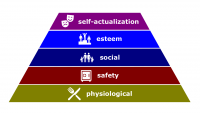 rightHierarchy of needs
rightHierarchy of needs - Two-factor theory (also known as motivation-hygiene theory). A theory that relates intrinsic factors to job satisfaction and associates extrinsic factors with dissatisfaction.
- Hygiene factor. A factor -- such as company policy and administration, supervision, and salary -- that, when adequate in a job, placates workers. When these factors are adequate, people will not be dissatisfied.
- McClelland's theory of needs. A theory that states achievement, power, and affiliation are three important needs that help explain motivation.
- Need for achievement. The drive to excel, to achieve in relationship to a set of standards, and to strive to succeed.
- Need for power. The need to make others behave in a way in which they would not have behaved otherwise.
- Need for affiliation. The desire for friendly and close interpersonal relationships.
- Self-determination theory. A theory of motivation that is concerned with the beneficial effects of extrinsic motivation.
- Cognitive evaluation theory. A version of self-determination theory that holds that allocating extrinsic rewards for behavior intristically rewarding tends to decrease the overall level of motivation if the rewards are seen as controlling.
- Self-concordance. The degree to which people's reasons for pursuing goals are consistent with their interests and core values.
- Goal-setting theory. A theory that says that specific and difficult goals, with feedback, lead to higher performance.
- Promotion focus. A self-regulation strategy that involves striving for goals through advancement and accomplishment.
- Prevention focus. A self-regulation strategy that involves striving for goals by fulfilling duties and obligations.
- Management by objectives. A program that encompasses specific goals, participatively set, for explicit time period, with feedback on goal progress.
- Self-efficacy theory. An individual's belief that he or she is capable of performing a task.
- Reinforcement theory. A theory that says that behavior is a function of its consequences.
- Behaviorism. A theory that argues that behavior follows stimuli in a relatively unthinking manner.
- Social-learning theory. The view that we can learn through both observation and direct experience.
- Equity theory. A theory that says that individuals compare their job inputs and outcomes with those of others and then respond to eliminate any inequities.
- Organizational justice. An overall perception of what is fair in the workplace, composed of distributive, procedural, informational, and interpersonal justice.
- Distributive justice. Perceived fairness of the amount and allocation of rewards among individuals.
- Procedural justice. The perceived fairness of the process used to determine the distribution of rewards.
- Informational justice. The degree to which employees are provided truthful explanations for decisions.
- Interpersonal justice. The degree to which employees are treated with dignity and respect.
- Expectancy theory. A theory that says that the strength of a tendency to act in a certain way depends on the strength of an expectation that the act will be followed by a given outcome and on the attractiveness of that outcome to the individual.
- Job engagement. The investment of an employee's physical, cognitive, and emotional energies into job performance.
Motivation applications
- Job design. The way the elements in a job are organized.
- Job Characteristics Model. A model that proposes that any job can be described in terms of five core job dimensions: skill variety, task identity, task significance, autonomy, and feedback.
- Skill variety. The degree to which a job requires a variety of different activities.
- Task identity. The degree to which a job requires completion of a whole and identifiable piece of work.
- Task significance. The degree to which a job has a substantial impact on the lives or work of other people.
- Autonomy. The degree to which a job provides substantial freedom and discretion to the individual in scheduling the work and in determining the procedures to be used in carrying it out.
- Feedback. The degree to which carrying out the work activities required by a job results in the individual obtaining direct and clear information about the effectiveness of his or her performance.
- Motivating potential score. A predictive index that suggests the motivating potential in a job.
- Job rotation. The periodic shifting of an employee from one task to another.
- Relational job design. Constructing jobs so employees see the positive difference they can make in the lives of others directly through their network.
- Flextime. Flexible work hours.
- Job sharing. An arrangement that allows two or more individuals to split a traditional 40-hour-a-week job.
- Telecommuting. Working remotely at least 2 days a week on a computer that is linked to the employer office.
- Employee involvement and participation. A participative process that uses the input of employees to increase employee commitment to organizational success.
- Participative management. A process in which subordinates share a significant degree of decision-making power with their immediate superiors.
- Representative participation. A system in which workers participate in organizational decision making through a small group of representative employees.
- Variable-pay program. A pay plan that bases a portion of an employee's pay on some individual and/or organizational measure of performance.
- Piece-rate pay plan. A pay plan in which workers are paid a fixed sum for each unit of production completed.
- Merit-based pay plan. A pay plan based on performance appraisal ratings.
- Bonus. A pay plan that rewards employees for recent performance rather than historical performance.
- Profit-sharing plan. An organization-wide program that distributes compensation based on some established formula designed around a company's profitability.
- Employee stock ownership plan. A company-established benefits plan in which employees acquire stock, often at below-market prices, as part of their benefits.
- Flexible benefits. A benefits plan that allows each employee to put together a benefits package individually tailored to his or her own needs and situation.
- Employee recognition program. A plan to encourage specific employee behaviors by formally appreciating specific employee contributions.
Group behavior
- Group. Two or more individuals, interacting and interdependent, who have come together to achieve particular objectives.
- Formal group. A designated workgroup defined by an organization's structure.
- Informal group. A group that is neither formally structured nor organizationally determined; such a group appears in response to the need for social contact.
- Social identity theory. Perspective that considers when and why individuals consider themselves members of groups.
- Ingroup favorism. Perspective in which we see members of our ingroup as better than other people, and people not in our group as all the same.
- Outgroup. The inverse of an ingroup, which can mean everyone outside the group, but more usually an identified other group.
- Punctuated-equilibrium model. A set of phases that temporary groups go through that involves transitions between inertia and activity.
- Role. A set of expected behavior patterns attributed to someone occupying a given position in a social unit.
- Role perception. An individual's view of how he or she is supposed to act in a given situation.
- Role expectations. How others believe a person should act in a given situation.
- Psychological contract. An unwritten agreement that sets out what management expects from an employee and vice versa.
- Role conflict. A situation in which an individual is confronted by divergent role expectations.
- Interrole conflict. A situation in which the expectations of an individual's different, separate groups are in opposition.
- Norm. An acceptable standard of behavior within a group that is shared by the group's members.
- Conformity. The adjustment of one's behavior to align with the norms of the group.
- Reference group. An important group to which individuals belong or hope to belong and with whose norms individuals are likely to conform.
- Deviant workplace behavior (also known as antisocial behavior or workplace incivility). Voluntary behavior that violates significant organizational norms and, in so doing, threatens the well-being of the organization or its members.
- Status. A socially defined position or rank given to groups or group members by others.
- Status characteristics theory. A theory that states that differences in status characteristics create status hierarchies within groups.
- Social loafing. The tendency for individuals to expend less effort when working collectively than when working individually.
- Cohesiveness. The degree to which group members are attracted to each other and are motivated to stay in the group.
- Faultiness. The perceived divisions that split groups into two or more subgroups based on individual differences such as sex, race, age, work experience, and education.
- Groupthink. A phenomenon in which the norm for consensus overrides the realistic appraisal of alternative courses of action.
- Groupshift. A change between a group's decision and individual decision that a member within the group would make; the shift can be toward either conservatism or greater risk but it generally is toward a more extreme version of the group's original position.
- Interacting group. A typical group in which members interact with each other face to face.
- Brainstorming. An idea-generation process that specifically encourages any and all alternatives while withholding any criticism of those alternatives.
- Nominal group technique. A group decision-making method in which individual members meet face to face to pool their judgments in a systematic but independent fashion.
- Group cohesion. The extend to which members of a group support and validate one another while at work.
- Group functioning. The quantity and quality of a group's work output.
- Workgroup. A group that interacts primarily to share information and to make decisions to help each group member perform within his or her area of responsibility.
Workteam
- Workteam. A group whose individual efforts result in performance that is greater than the sum of the individual inputs.
- Problem-solving team. A workteam of 5 to 12 employees from the same department who meet for a few hours each week to discuss ways of improving quality, efficiency, and the work environment.
- Self-managed work team. A workteam of 10 to 15 people who take on responsibilities of their former supervisors.
- Cross-functional team. A workteam of employees from about the same hierarchical level, but from different work areas, who come together to accomplish a task.
- Virtual team. A workteam that use computer technology to tie together physically dispersed members in order to achieve a common goal.
- Multiteam system. A collection of two or more interdependent teams that share a superordinate goal; a team of teams.
- Reflexivity. A team characteristic of reflecting on and adjusting the master plan when necessary.
- Team efficacy. A team's collective belief that they can succeed at their tasks.
- Team identity. A team member's affinity for and sense of belongingness to his or her team.
- Team cohesion. A situation when team members are emotionally attached to one another and motivated toward the team because of their attachment.
- Mental model. Team members' knowledge and beliefs about how the work gets done by the team.
- Team building. High interaction among team members to increase trust and openness.
Communication
- Communication. The transfer and the understanding of meaning.
- Communication process. The steps between a source and a receiver that results in the transfer and understanding of meaning.
- Formal channel. A communication channel established by an organization to transmit messages related to the professional activities of members.
- Informal channel. A communication channel that is created spontaneously and that emerges as a response to individual choices.
- Grapevine. An organization's informal communication network.
- Channel richness. The amount of information that can be transmitted during a communication episode.
- Automatic processing. A relatively superficial consideration of evidence and information making use of heuristics.
- Controlled processing. A detailed consideration of evidence and information relying on facts, figures, and logic.
- Need for cognition. A personality trait of individuals depicting the ongoing desire to think and learn.
- Filtering. A sender's manipulation of information so that it will be seen more favorably by the receiver.
- Information overload. A condition in which information inflow exceeds an individual's processing capacity.
- Communication apprehension. Undue tension and anxiety about oral communication, written communication, or both.
- High-context culture. A culture that relies heavily on nonverbal and subtle situational cues in communication.
- Low-context culture. A culture that relies heavily on words to convey meaning in communication.
Leadership
- Leadership. The ability to influence a group toward the achievement of a vision or set of goals.
- Trait theory of leadership. One of theories that consider personal qualities and characteristics that differentiate leaders from nonleaders.
- Behavioral theories of leadership. One of theories proposing that specific behaviors differentiate leaders from nonleaders.
- Initiating structure. The extent to which a leader is likely to define and structure his or her role and those of subordinates in the search for goal attainment.
- Consideration. The extent to which a leader is likely to have job relationships characterized by mutual trust, respect for subordinates' ideas, and regard for their feelings.
- Fiedler contingency model. The theory that effective groups depend on a proper match between a leader's style of interacting with subordinates and the degree to which the situation gives control and influence to the leader.
- Least preferred coworker questionnaire. An instrument that purports to measure whether a person is task or relationship oriented.
- Leader-member relations. The degree of confidence, trust, and respect subordinates have in their leader.
- Task structure. The degree to which job assignments are procedurized.
- Position power. Influence derived from one's formal structural position in the organization; includes power to hire, fire, discipline, promote, and give salary increases.
- Situational leadership theory (Hersey-Blanchard Situational Leadership Theory). A contingency theory that focuses on followers' readiness.
- Path-goal theory. A theory that states that it is the leader's job to assist followers in attaining their goals and to provide the necessary direction and/or support to ensure that their goals are compatible with the overall objectives of the group or organization.
- Leader-participation model. A leadership theory that provides a set of rules to determine the form and amount of participative decision making in different situations.
- Leader-member exchange theory. A theory that supports leaders' creation of ingroups and outgroups; subordinates with ingroup status will have higher performance ratings, less turnover, and greater job satisfaction.
- Charismatic leadership theory. A leadership theory that states that followers make attributions of heroic and extraordinary leadership abilities when they observe certain behaviors.
- Vision. A long-term strategy for attaining a goal or goals.
- Vision statement. A formal articulation of an organization's vision or mission.
- Transactional leader. A leader who guides or motivates his or her followers in the direction of established goals by clarifying role and task requirements.
- Transformational leader. A leader who inspires his or her followers to transcend their own self-interests and who is capable of having a profound and extraordinary effect on followers.
- Full Range Leadership Model. A model that depicts seven management styles on a continuum: laissez-faire, management by exception, contingent reward leadership, individualized consideration, intellectual stimulation, inspirational motivation, and idealized influence.
- Authentic leader. A leader who knows who he or she is, knows what he or she believes in and values, and acts on those values and beliefs openly and candidly. Their followers would consider them to be ethical people.
- Socialized charismatic leadership. A leadership concept that states that leaders convey values that are other-centered versus self-oriented and who role-model ethical conduct.
- Servant leadership. A leadership style marked by going beyond the leader's own self-interest and instead focusing on opportunities to help followers grow and develop.
- Trust. A positive expectation that another will not act opportunistically.
- Trust propensity. How likely an employee is to trust a leader.
- Mentor. A senior employee who sponsors and supports a less-experienced employee, called a protégé.
- Attribution theory of leadership. A leadership theory that says that leadership is merely an attribution that people make about other individuals.
- Leader substitute. An attribute or set of attributes, such as experience and training, that can replace the need for a leader's support or ability to create structure.
- Leader neutralizer. An attribute or set of attributes that make it impossible for leader behavior to make any difference to follower outcomes.
- Identification-based trust. Trust based on a mutual understanding of each other's intentions and appreciation of each other's wants and desires.
Power
- Power. A capacity that A has to influence the behavior of B so that B acts in accordance with A's wishes.
- Dependence. B's relationship to A when A possesses something that B requires.
- Coercive power. A power base that is dependent on fear of the negative effects from failing to comply.
- Reward power. Compliance achieved based on the ability to distribute rewards that others view as valuable.
- Legitimate power. The power a person receives as a result of his or her position in the formal hierarchy of an organization.
- Expert power. Influence based on special skills or knowledge.
- Referent power. Influence based on identification with a person who has desirable resources or personal traits.
- Power tactic. A way in which individuals translate power bases into specific actions.
Politics
- Political skill. The ability to influence others in such a way as to enhance one's objectives.
- Sexual harassment. Any unwanted activity of a sexual nature that affects an individual's employment and creates a hostile work environment.
- Political behavior. Activities that are not required as part of a person's formal role in the organization but that influence, or attempt to influence, the distribution of advantages and disadvantages within the organization.
- Zero-sum approach. An approach that treats the reward "pie" as fixed, such as that any gains by one individual are at the expense of another.
- Defensive behavior. Reactive and protective behaviors to avoid action, blame, or change.
- Impression management. The process by which individuals attempt to control the impression others form of them.
Conflict
- Conflict. A process that begins when one party perceives that another party has negatively affected, or is about to negatively affect, something that the first party cares about.
- Functional conflict. Conflict that supports the goals of the group and improves its performance.
- Dysfunctional conflict. Conflict that hinders group performance.
- Task conflict. Conflict over content and goals of the work.
- Relationship conflict. Conflict based on interpersonal relationships.
- Process conflict. Conflict over how work gets done.
- Dyadic conflict. Conflict that occurs between two people.
- Intragroup conflict. Conflict that occurs within a group or team.
- Intergroup conflict. Conflict that occurs between different groups or teams.
- Conflict process. A process that has five stages: potential opposition or incompatibility, cognition and personalization, intentions, behavior, and outcomes.
- Perceived conflict. Awareness by one or more parties of the existence of conditions that create opportunities for conflict to arise.
- Felt conflict. Emotional involvement in a conflict that creates anxiety, tenseness, frustration, or hostility.
- Intention. A decision to act in a given way.
- Competing. A desire to satisfy one's interests, regardless of the impact on the other party of the conflict.
- Collaborating. A situation in which the parties to a conflict each desire to satisfy fully the concerns of all parties.
- Avoiding. The desire to withdraw from or suppress a conflict.
- Accommodating. The willingness of one party in a conflict to place the opponent's interests above his or her own.
- Compromising. A situation in which each party to a conflict is willing to give up something.
- Conflict management. The use of resolution and stimulation techniques to achieve the desired level of conflict.
Negotiation
- Negotiation. A process in which two or more parties exchange goods or services and attempt to agree on the exchange rate for them.
- Distributive bargaining. Negotiation that seeks to divide up a fixed amount of resources; a win-lose situation.
- Fixed pie. The belief that there is only a set amount of goods and services to be divided up between the parties.
- Integrative bargaining. Negotiation that seeks one or more settlements that can create a win-win solution.
- BATNA. The best alternative to a negotiated agreement; the least the individual should accept.
- Mediator. A neutral third party who facilitates a negotiated solution by using reasoning, persuasion, and suggestions for alternatives.
- Arbitrator. A third party to a negotiation who has the authority to dictate an agreement.
- Conciliator. A trusted third party who provides an informal communication link between the negotiator and the opponent.
Organizational structure
- Organizational structure. The way in which job tasks are formally divided, grouped, and coordinated.
- Work specialization. The degree to which tasks in an organization are subdivided into separate jobs.
- Departmentalization. The basis by which jobs in an organization are grouped together.
- Chain of command. The unbroken line of authority that extends from the top of the organization to the lowest echelon and clarifies who reports to whom.
- Authority. The rights inherent in a managerial position to give orders and to expect the orders to be obeyed.
- Unity of command. The idea that a subordinate should have only one superior to whom he or she is directly responsible.
- Span of control. The number of subordinates a manager can effectively and efficiently direct.
- Centralization. The degree to which decision making is concentrated at a single point in an organization.
- Formalization. The degree to which jobs within an organization are standardized.
- Boundary spanning. When individuals form relationships outside their formally assigned groups.
- Simple structure. An organizational structure characterized by a low degree of departmentalization, wide spans of control, authority centralized in a single person, and little formalization.
- Bureaucracy. An organizational structure with highly routine operating tasks achieved through specialization, very formalized rules and regulations, tasks that are grouped into functional departments, centralized authority, narrow spans of control, and decision making that follows the chain of command.
- Functional structure. An organizational structure that groups employees by their similar specialties, roles, and tasks.
- Divisional structure. An organizational structure that groups employees into units by product, service, customer, or geographical market area.
- Matrix structure. An organizational structure that creates dual lines of authority and combines functional and product departmentalization.
- Virtual structure. A small, core organization that outsources major business functions.
- Team structure. An organizational structure that replaces departments with empowered teams, and which eliminates horizontal boundaries and external barriers between customers and suppliers.
- Circular structure. An organizational structure in which executives are at the center, spreading their vision outward in rings grouped by function (managers, then specialists, then workers).
- Mechanistic structure. A structure characterized by extensive departmentalization, high formalization, a limited information network, and centralization.
- Organic structure. A structure that is flat, uses cross-hierarchical and cross-functional teams, has low formalization, possesses a comprehensive information network, and relies on participative decision making.
- Innovation strategy. A strategy that emphasizes the introduction of major new products and services.
- Cost-minimization strategy. A strategy that emphasizes tight cost controls, avoidance of unnecessary innovation or marketing expenses, and price cutting.
- Imitation strategy. A strategy that seeks to move into new products or new markets only after their viability has already been proven.
- Technology. The way in which an organization transfers its inputs into outputs.
- Environment. Forces outside an organization that potentially affect the organization's structure.
- Institutions. Cultural factors that lead many organizations to have similar structures, especially those factors that might not lead to adaptive consequences.
Organizational culture
- Organizational culture. A system of shared meaning held by members that distinguishes the organization from other organizations.
- Dominant culture. A culture that expresses the core values that are shared by a majority of the organization's members.
- Organizational value. The primary or dominant value that is accepted throughout the organization.
- Organizational subculture. A miniculture within an organization, typically defined by department designations and geographical separation.
- Strong culture. A culture in which the core values are intensely held and widely shared.
- Organizational climate. The shared perceptions organizational members have about their organization and work environment.
- Ethical work climate. The shared concept of right and wrong behavior in the workplace that reflects the true values of the organization and shapes the ethical decision making of its members.
- Sustainability. Organization practices that can be sustained over a long period of time because the tools or structures that support them are not damaged by the processes.
- Institutionalization. A condition that occurs when an organization takes on a life of its own, apart from any of its members, and acquires immortality.
- Socialization. A process that adapts employees to the organization's culture.
- Prearrival stage. The period of learning in the socialization process that occurs before a new employee joins the organization.
- Encounter stage. The stage in the socialization process in which a new employee sees what the organization is really like and confronts the possibility that expectations and reality may diverge.
- Metamorphosis stage. The stage in the socialization process in which a new employee changes and adjusts to the job, work group, and organization.
- Ritual. A repetitive sequence of activities that express and reinforce the key values of the organization, which goals are most important, which people are important, and which are expendable.
- Material symbol. What conveys to employees who is important, the degree of egalitarianism top management desires, and the kinds of behavior that are appropriate.
- Positive organizational culture. An organizational culture that emphasizes building on employee strengths, rewards more than punishes, and emphasizes individual vitality and growth.
- Workplace spirituality. The recognition that people have an inner life that nourishes and is nourished by meaningful work that takes place in the context of community.
HR
- Work sample test. A hands-on simulation of part or all of the work that applicants for routine jobs must perform.
- Assessment center. An off-site place where candidates are given a set of performance simulation tests designed to evaluate their managerial potential.
- Situational judgment test. A substantive selection test that asks applicants how they would perform in a variety of job situations; the answers are then compared to the answers of high-performing employees.
- Realistic job preview. A substantive selection test that is a job tryout to assess talent versus experience.
- Unstructured interview. A short, casual interview made up of random questions.
- Structured interview. A planned interview designed to gather job-related information.
- Panel interview. A structured interview conducted with a candidate and a number of panel members in a joint meeting.
- Task performance. The combination of effectiveness and efficiency at doing your core job tasks.
- Organizational citizenship. Actions that contribute to the psychological environment of the organization, such as helping others when not required.
- Counterproductivity. Actions that actively damage the organization, including stealing, behaving aggressively toward coworkers, of being late or absent.
- Critical incident. A way of evaluating the behaviors that are key in making the difference between executing a job effectively and executing it ineffectively.
- Graphic rating scale. An evaluation method in which the evaluator rates performance factors on an incremental scale.
- Behaviorally anchored rating scale. A scale that combine major elements from the critical incident and graphic rating scale approaches. The appraiser rates the employees based on items along a continuum, but the points are examples of actual behavior on the given job rather than general descriptions or traits.
- Forced comparison. Method of performance evaluation where an employee's performance is made in explicit comparison to others (e.g., an employee may rank third out of 10 employees in his or her work unit).
- Group order ranking. An evaluation method that places employees into a particular classification, such as quartiles.
- Individual ranking. An evaluation method that rank-orders employees from best to worst.
Organizational change
- Organizational change. Making things different.
- Planned change. Change activities that are intentional and goal oriented.
- Change agent. A person who acts as a catalyst and assumes the responsibility for managing change activities.
- Driving force. A force that directs behavior away from status quo (Kurt Lewin).
- Restraining force. A force that hinders movement from the existing equilibrium (Kurt Lewin).
- Action research. A change process based on systematic collection of data and then selection of a change action based on what the analyzed data indicate.
- Organizational development. A collection of planned change interventions, built on humanistic-democratic values, that seeks to improve organizational effectiveness and employee well-being.
- Sensitivity training. Training groups that seek to change behavior through unstructured group interaction.
- Survey feedback. The use of questionnaires to identify discrepancies among member perceptions; discussion follows, and remedies are suggested.
- Process consultation. A meeting in which a consultant assists a client in understanding process events with which he or she must deal and identifying processes that need improvement.
- Intergroup development. Organizational development efforts to change the attitudes, stereotypes, and perceptions that groups have of each other.
- Appreciative inquiry. An approach that seeks to identify the unique qualities and special strengths of an organization, which can then be built on to improve performance.
- Paradox theory. The theory that the key paradox in management is that there is no final status for an organization.
- Innovation. A new idea applied to initiating or improving a product, process, or service.
- Idea champion. An individual who takes an innovation and actively and enthusiastically promote the idea, build support, overcome resistance, and ensure that the idea is implemented.
- Learning organization. An organization that has developed the continuous capacity to adapt and change.
Stress management
- Stress. An unpleasant psychological process that occurs in response to environmental pressures.
- Challenge stressor. A stressor associated with workload, pressure to complete tasks, and time urgency.
- Hindrance stressor. A stressor that keep you from reaching your goals (for example, red tape, office politics, confusion over job responsibilities).
- Work demand. A responsibility, pressure, obligation, and even uncertainty that individuals face in the workplace.
- Work resource. A thing within an individual's control that can be used to solve work demands.
- Allostasis. Working to change behavior and attitude to find stability.
- Wellness program. An organizationally supported program that focuses on the employee's total physical and mental condition.
